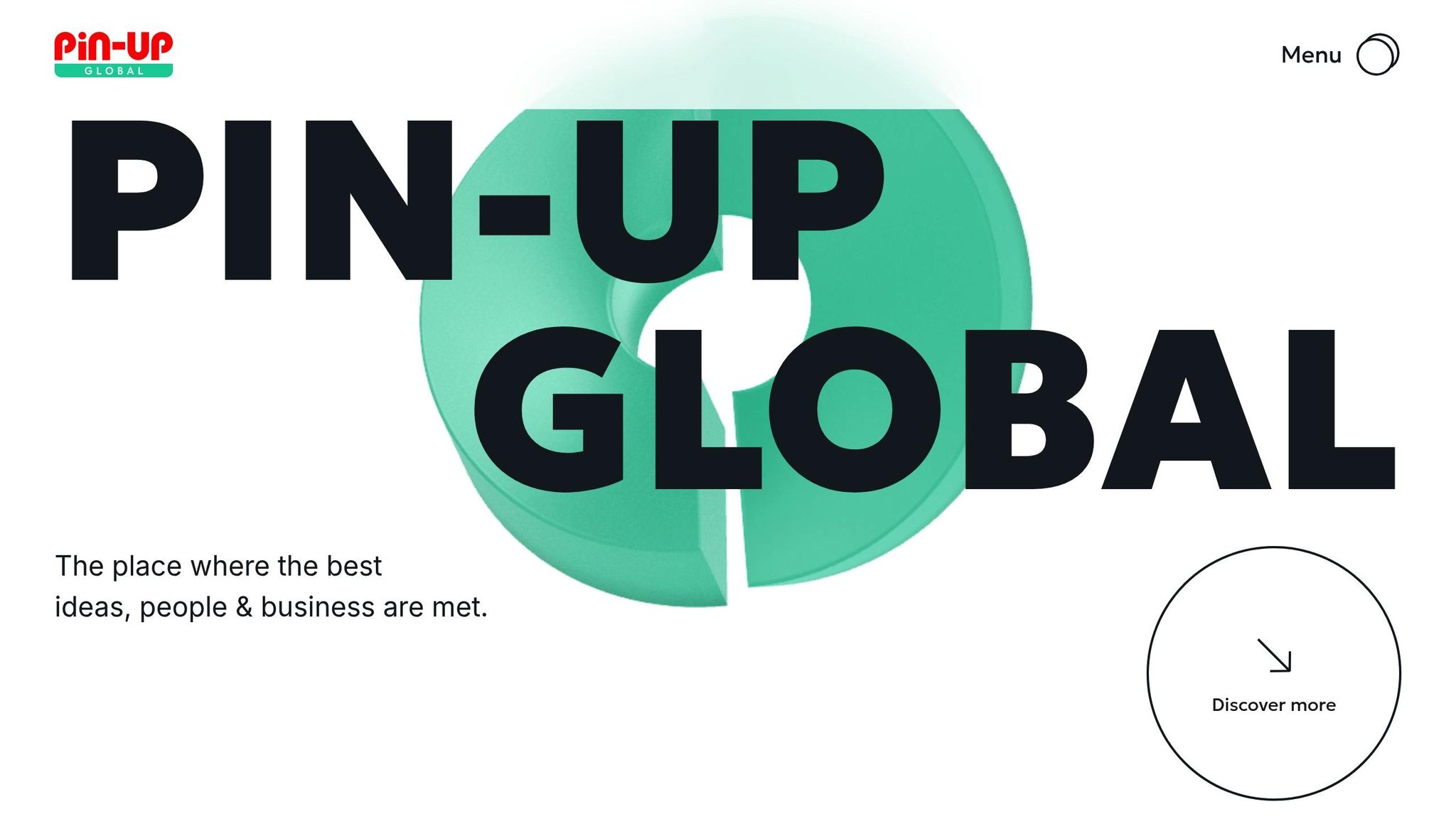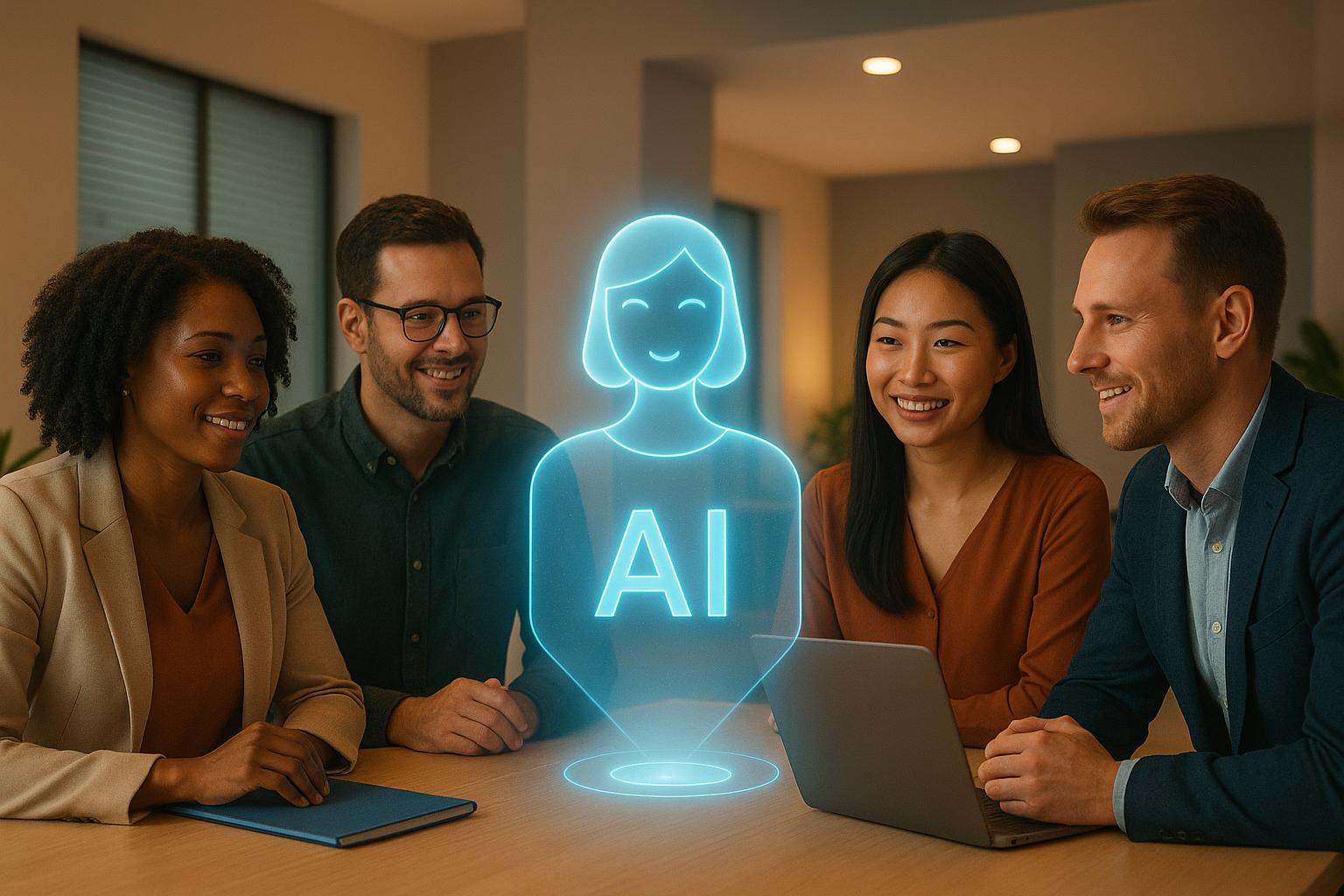AI is transforming how companies approach hiring, especially in the competitive U.S. IT job market. By addressing common challenges like delays, unclear communication, and repetitive tasks, AI creates a smoother, more engaging process for candidates. Here’s how:
- Instant Communication: AI chatbots provide 24/7 support, answer questions, and guide candidates through applications, reducing recruiter workload.
- Personalized Job Matches: AI analyzes resumes and preferences to suggest roles tailored to candidates’ skills and career goals.
- Efficient Scheduling: Automated tools let candidates select interview times and receive real-time updates, cutting down back-and-forth emails.
- Bias Reduction: AI standardizes evaluations, ensuring hiring decisions focus on skills and qualifications, not unconscious biases.
- Faster Hiring: Companies using AI report shorter time-to-fill metrics and higher application completion rates.
For IT professionals, who often juggle multiple offers, these improvements make a hiring process more appealing. Companies like Equifier use AI to streamline recruitment for specialized roles in fields like cybersecurity and cloud computing while ensuring recruiters can focus on building meaningful relationships.
How AI Helped Us Hire 1,400 Specialists: Inside PIN-UP Partners’ Game-Changing Recruitment Strategy

What Is Candidate Experience in IT Recruitment
Candidate experience in IT recruitment encompasses every interaction a candidate has with a company, starting from the job posting all the way to the final communication. It plays a key role in shaping how candidates perceive the company’s technical capabilities, workplace culture, and respect for their specialized skills.
A positive experience hinges on several factors: clear and timely communication, a smooth application process, tailored job recommendations, and transparency throughout the hiring journey. IT professionals, in particular, expect quick feedback, opportunities to showcase their expertise, and a hiring process that values their time and technical skills. This is especially critical in the highly competitive U.S. IT market, where top talent is often in high demand.
The stakes are even higher in IT recruitment because these roles often require niche skills in areas like software development, cloud computing, cybersecurity, artificial intelligence, and machine learning. IT candidates are quick to evaluate whether a company’s hiring process aligns with the technical standards of their field. Leveraging tools like AI can enhance these interactions, helping to close gaps and improve the overall recruitment experience.
Why Candidate Experience Matters for IT Recruitment
The U.S. IT job market is fiercely competitive, with top professionals frequently juggling multiple job offers. In such an environment, candidate experience isn’t just a nice-to-have – it’s a critical factor in attracting and retaining top-tier talent. A smooth, respectful process not only boosts the likelihood of offer acceptance but also strengthens employer branding through positive reviews and referrals. This is especially valuable in the tight-knit IT community, where reputations spread quickly.
When skilled professionals like developers, cybersecurity experts, or cloud architects have a seamless hiring experience, they are more likely to accept offers, recommend the company to peers, and even consider future opportunities with the same employer. Companies that have embraced AI-driven recruitment strategies report clear benefits, such as increased application completion rates, shorter time-to-fill metrics, and higher return rates from candidates.
On the flip side, a poor candidate experience can tarnish your reputation and make future hiring efforts more challenging. In IT, where professionals often network through conferences, online forums, and prior collaborations, negative experiences can ripple through the community, shrinking your pool of potential hires.
Common Problems IT Candidates Face During Hiring
Despite advancements, IT candidates still encounter several pain points in traditional hiring processes:
- Long hiring timelines: Delays can push top candidates toward faster-moving competitors.
- Inconsistent communication: IT professionals expect straightforward updates on their application status and next steps.
- Unclear job descriptions: Ambiguity around role requirements can leave candidates unsure if they’re a good fit.
- Repetitive assessments: Multiple coding challenges or technical tests that don’t reflect the actual job can frustrate experienced candidates.
- Perceived bias in evaluations: Traditional screening methods can unintentionally favor certain backgrounds, leaving qualified candidates feeling overlooked.
One real-world example of addressing these issues comes from Stanford Health Care. In 2023, they introduced an AI chatbot that managed 250,000 interactions in just six months. This tool streamlined candidate communication while significantly reducing administrative workload.
Companies like Equifier, which specializes in sourcing top-tier IT talent for both permanent and contract roles, understand how vital it is to address these challenges. With a focus on cybersecurity consulting and IT services, they recognize that IT professionals expect a hiring process that prioritizes speed, precision, and respect for their specialized expertise.
How AI Improves the Candidate Journey
AI is reshaping the recruitment process by addressing common challenges IT candidates face, such as long delays and unclear procedures. With AI, candidates experience a smoother journey, marked by instant support, tailored guidance, and transparent communication. Let’s break down how these tools elevate the hiring experience.
AI Chatbots for Instant Communication
AI chatbots have changed the way candidates interact with potential employers by providing round-the-clock responses to questions and concerns. These virtual assistants guide applicants through the application process, answering queries about company values, job roles, and next steps, ensuring candidates stay informed and engaged.
Take Stanford Health Care, for example. In 2023, they introduced an AI chatbot that managed 250,000 candidate interactions in just six months. This innovation drastically reduced recruiter support tickets from 50 per week to just one or two, allowing recruiters to focus on building meaningful connections instead of addressing repetitive questions.
Beyond answering FAQs, the chatbot allowed candidates to complete applications on mobile devices, pause, and resume later – all while offering immediate help if issues arose. This accessibility proved essential for IT professionals, who often explore job opportunities outside traditional working hours.
For companies like Equifier, which specializes in recruiting top IT talent, AI chatbots not only handle initial screenings but also escalate complex technical inquiries – like those about cybersecurity or IT consulting – to human experts when needed.
Personalized Job Recommendations
AI excels at matching candidates with roles that align with their skills, experience, and career aspirations. By analyzing resumes, application history, and online behavior, AI delivers tailored job suggestions, saving IT professionals from sifting through irrelevant postings.
For instance, AI systems can identify when a cybersecurity expert might thrive in a cloud security role or when a software developer’s background aligns with DevOps opportunities. This nuanced understanding helps candidates uncover career paths they might not have considered, while employers connect with talent that fits their needs.
One AI-powered chatbot demonstrated this capability by asking candidates targeted questions about their technical expertise and immediately suggesting relevant positions. This approach led to 11,000+ candidate leads and over 12,000 application clicks in just six months.
Automated Scheduling and Status Updates
AI-powered scheduling tools simplify the interview process by letting candidates choose interview times based on real-time recruiter availability. This eliminates back-and-forth emails, speeds up scheduling, and gives candidates more control over their calendars.
Automated status updates keep candidates informed at every stage, from application receipt to interview feedback. These timely notifications reduce anxiety and show respect for candidates’ time and effort.
The impact is clear: AI reduced average days-to-offer by 41 days, a critical improvement in the fast-paced IT job market where top talent often juggles multiple offers. Recruiters also benefit from better pipeline visibility, allowing them to identify candidates needing extra attention and ensure no one slips through the cracks.
Reducing Bias in Candidate Evaluation
AI plays a key role in creating fairer hiring processes by standardizing evaluations. Using criteria-based analysis, AI screens resumes and assesses candidates based on skills and qualifications, minimizing the influence of unconscious bias.
For example, AI can anonymize resumes by removing names, addresses, and educational institutions, focusing solely on relevant experience and technical competencies. It also flags biased language in job descriptions, helping companies craft inclusive postings that attract diverse talent pools – an essential step in IT recruitment.
AI’s structured approach extends to interviews. Video assessments powered by AI apply consistent evaluation criteria, ensuring technical skills and problem-solving abilities are prioritized equally for all candidates. For specialized IT roles like cybersecurity or cloud architecture, this objective approach ensures hiring decisions are based on merit, fostering diversity while identifying top talent.
How to Implement AI Tools for Better Candidate Experience
Using AI effectively means integrating it into your systems in a way that complements human interaction, not replaces it. Here’s how to make that happen.
Connecting AI with Applicant Tracking Systems (ATS)
Pairing AI with your existing Applicant Tracking System (ATS) creates a centralized hub where candidate information moves smoothly between automated and manual processes. This setup allows AI to handle tasks like fetching candidate data, tracking interactions, and providing actionable insights – all while keeping your workflows intact.
The first step? Choose AI tools that work seamlessly with your ATS. Many popular systems support integrations that automate tasks like initial screenings or scheduling interviews, while still allowing recruiters to step in when needed.
Take Brother International Corporation as an example. By connecting an AI-powered career site to their ATS, they saw a 140% jump in completed applications and reduced their time-to-fill positions by 25%. This integration not only sped up their processes but also gave candidates confidence through clear and consistent communication.
For IT recruiters, like those at Equifier, ATS integration is especially useful for managing technical roles. AI can identify candidates with specific certifications – like cybersecurity or cloud architecture – while ensuring sensitive data stays secure through robust IT infrastructure.
From a technical standpoint, integrating AI with an ATS often involves API connections. These connections sync candidate profiles, application statuses, and communication histories, creating a single source of truth. This way, recruiters can combine AI’s data-driven insights with their expertise to make smarter decisions about technical fit and team alignment.
Creating Personalized Career Portals with AI
Once your ATS and AI tools are linked, the next step is to create personalized career portals. These AI-powered platforms turn static job boards into dynamic experiences tailored to each candidate’s skills and interests. By analyzing behavior – like which job descriptions a candidate reads or the skills they highlight – AI continuously refines job recommendations.
For instance, Brother International Corporation’s AI-driven career site boosted page views by 45% because candidates found roles that matched their backgrounds more easily. Whether someone was exploring cybersecurity jobs or cloud infrastructure roles, the AI surfaced relevant opportunities based on their preferences.
To build such a portal, choose platforms that use machine learning to understand candidate behavior. Configure recommendation engines to account for factors like technical skills, experience, and location. For IT positions, this could mean distinguishing between a DevOps engineer focused on containerization and a security analyst specializing in compliance frameworks.
For companies like Equifier, these personalized portals ensure candidates are matched with roles that align closely with their qualifications, especially in specialized fields like IT and cybersecurity.
Balancing Automation with Human Interaction
AI can handle a lot, but it’s important to let human expertise shine where it matters most. Balancing automation with personal interaction is key to delivering a great candidate experience. While AI can take care of repetitive tasks – like initial screenings, scheduling, and follow-ups – recruiters should step in for critical conversations about technical requirements, career goals, and team dynamics.
This balance is particularly important in IT recruitment, where candidates expect both speed and a personal touch. For example, Humanly.io allows recruiters to intervene at any point in the automated process. This ensures that complex questions or concerns – like those about specific technical skills – are addressed by a real person.
The trick is to create clear transitions between AI and human interactions. Candidates should always know whether they’re interacting with an automated system or a recruiter. This transparency builds trust and sets realistic expectations for response times and the level of detail in conversations.
Training is also essential. Recruiters need to understand how to use AI tools effectively, when to step in, and how to leverage automated insights during candidate discussions. With the right training, they can focus on high-value tasks like technical assessments and relationship building, while trusting AI to handle routine communications.
Finally, keep an eye on how things are working. Regularly track metrics like candidate satisfaction, application completion rates, and feedback on the process. This helps identify whether automation is creating bottlenecks or if more human involvement is needed to improve the experience.
sbb-itb-05efa2a
Best Practices for AI-Driven Recruitment
AI is reshaping how companies approach recruitment, especially in communication and scheduling. But to truly benefit from AI, it’s not just about using the right tools – it’s about designing workflows that work well for both candidates and your team. These practices aim to create a smooth, candidate-first hiring experience while complementing earlier AI advancements.
Setting Up Automated Communication Workflows
Use AI to build personalized, multi-channel communication workflows that keep candidates informed at every stage. Whether through email, SMS, or chatbots, automate updates for application receipt, interview scheduling, and final decisions. Each message should align with your employer brand and provide clear next steps.
The numbers speak for themselves: one AI-driven system managed 250,000 candidate interactions over six months, resulting in 11,000+ leads and 12,000 application clicks, while cutting recruiter support tickets from 50 per week to just 1–2.
Personalization is key. AI can analyze candidate data – such as skills, experience, and role type – to tailor messages. For instance, a cybersecurity candidate could receive updates about your company’s security certifications, while a cloud architect might get insights into your infrastructure practices. This level of customization ensures candidates feel valued and informed.
For technical roles, consider including helpful resources like interview preparation tips or an overview of your technology stack. These small touches can make a big difference in how candidates perceive your company.
Providing Clear Feedback and Updates
Transparency and meaningful feedback go a long way in building trust with candidates. AI makes it easier to deliver specific, actionable feedback at scale. Aim to provide feedback within one week of initial screenings and within two weeks of final decisions.
Instead of sending generic rejection emails, use AI to analyze interview data and application details to offer constructive feedback. For example, after a technical assessment, a candidate might receive feedback like: "Your knowledge of cloud architecture is strong, especially in containerization. To strengthen your profile for similar roles, consider gaining more experience with serverless technologies."
Even when there’s no news, AI can automatically send updates to reassure candidates that their application is still under review and provide an estimated timeline. AI-powered video assessments are particularly useful for structured feedback, offering insights into communication style, technical explanations, and areas for improvement.
To avoid robotic-sounding responses, rely on AI to craft personalized feedback rather than using pre-written templates. The goal is to make every candidate feel like their experience was thoughtfully considered, even when managing large-scale hiring.
Compliance and Privacy in AI Recruitment
While AI can streamline recruitment, it’s critical to prioritize data security and fairness. In the United States, AI recruitment tools must comply with regulations like the California Consumer Privacy Act (CCPA) and adhere to ethical hiring standards.
Start with transparent data collection. Provide clear privacy notices that explain what information you’re collecting, how it will be used, and how long it will be stored. Candidates should also have the ability to access, update, or delete their data easily. Be upfront about whether their information will only be used for the current role or saved for future opportunities.
AI introduces complexities in consent management, as these systems often analyze patterns or behaviors candidates might not expect. Clearly explain how AI evaluates applications, what data points influence decisions, and how algorithmic scoring works.
To ensure fairness, conduct regular bias audits to identify and address potential disparities in AI decision-making. AI systems can unintentionally discriminate based on factors like educational background or language patterns. Schedule quarterly reviews to monitor outcomes across different candidate groups.
Using explainable AI models is another way to maintain transparency. If a candidate asks why they weren’t selected, your team should be able to provide clear, AI-generated reasoning rather than vague explanations.
For IT recruitment, compliance is especially critical since you may handle sensitive information like technical skills, security clearances, and project details. Ensure your AI tools integrate seamlessly with your existing cybersecurity systems to avoid creating vulnerabilities.
Data security measures such as encryption, secure storage, and restricted access are non-negotiable. Regular security assessments can help safeguard candidate data throughout the hiring process.
Lastly, establish appeal processes so candidates can challenge AI-driven decisions they believe are unfair. This could involve human review of AI recommendations or giving candidates the opportunity to provide additional information that wasn’t captured initially. This approach not only builds trust but also ensures fairness in your hiring process.
Measuring AI’s Impact on Candidate Experience
AI has reshaped how candidates interact with recruitment processes, but measuring its impact is crucial to refine strategies and prove its value. Without proper tracking, you risk missing opportunities to enhance workflows or demonstrate the benefits AI brings to your organization.
Key Metrics to Track Success
When evaluating AI in recruitment, focus on metrics that highlight efficiency, engagement, and satisfaction. Here’s where to start:
- Time-to-hire: This measures the average number of days from application to offer. A shorter time-to-hire often suggests AI is streamlining processes effectively.
- Application completion rates: High completion rates indicate that AI tools, like chatbots, are engaging candidates by providing clear guidance and personalized support. Candidates are less likely to abandon the process midway.
- Drop-off rates: Pinpointing where candidates exit – whether during screening, scheduling, or interviews – helps identify friction points. AI analytics can uncover patterns and suggest improvements.
- Candidate satisfaction scores: Post-process surveys can reveal how candidates feel about the experience. Questions like, "Was it easy to get updates on your application status?" or "Did the process feel fair and transparent?" offer valuable insights.
- Quality of hire: Measuring post-hire performance and retention ensures that improving the candidate experience doesn’t compromise hiring quality. The best AI systems enhance both experience and outcomes.
These metrics provide a clear picture of how AI impacts recruitment at each stage, aligning with earlier discussions on ATS and AI integrations.
Comparing Before and After AI Implementation
Side-by-side comparisons can illustrate AI’s tangible benefits. Take Brother International Corporation as an example. After launching an AI-powered career site and CRM in January 2023, they saw dramatic results in just three weeks:
- 140% increase in completed applications
- 45% increase in page views
- 40% increase in job seekers
- 15% increase in returning job seekers
- 25% decrease in time-to-fill positions
Here’s a snapshot of their results:
| Metric | Before AI | After AI | Improvement |
|---|---|---|---|
| Application Completion Rate | Baseline | +140% | More candidates completing applications |
| Time to Fill Positions | Baseline | –25% | Faster hiring process |
| Returning Job Seekers | Baseline | +15% | Repeat visits driven by better experience |
| Days to Offer | Baseline | –41 days | Streamlined decision-making |
These results underscore how AI can transform recruitment outcomes. To fully understand its impact, track both quantitative metrics (like completion rates) and qualitative improvements (like feedback from candidates). Some benefits, such as stronger employer branding or higher-quality candidate pools, might take months to materialize, so continue monitoring over time.
Continuous Improvement Through Analytics
AI-powered analytics provide ongoing insights to refine your recruitment strategy. Here’s how to make the most of them:
- Automated dashboards: Use these to track trends in candidate behavior, communication effectiveness, and bottlenecks. Spotting high drop-off rates or recurring feedback themes allows for targeted improvements.
- Sentiment analysis: Go beyond satisfaction scores by analyzing email responses, chat interactions, and survey comments. This helps uncover frustration points or positive experiences you might otherwise overlook.
- Quarterly reviews: Combine data with qualitative feedback from candidates and recruiters. Reviewing AI-generated reports alongside testimonials can reveal improvement opportunities numbers alone might miss.
- A/B testing: Test different message templates, scheduling options, or feedback formats to see what resonates most with candidates. AI tools can track results and recommend the most effective approaches.
- Predictive analytics: Anticipate challenges like candidate drop-offs or delays in decision-making. AI can flag these issues early, allowing your team to intervene proactively.
For IT recruitment, it’s worth tracking metrics specific to technical roles, such as feedback on technical assessments and process efficiency. Tools like Equifier can streamline data integration and provide real-time analytics tailored to these needs.
Finally, communicate improvements back to candidates and your team. Sharing how AI-driven insights have led to changes builds trust and demonstrates your commitment to refining the process. Integrating AI tools with existing systems like ATS platforms, communication tools, and survey software ensures you capture a complete view of the candidate journey.
Conclusion: Using AI to Transform Recruitment
AI is reshaping how organizations manage the candidate experience in IT recruitment. Case studies highlight impressive outcomes, such as higher application completion rates and improved support efficiency, when AI tools are thoughtfully implemented.
By strategically integrating AI, recruitment processes become more streamlined. Tasks like resume screening, scheduling interviews, and handling initial communications are managed efficiently, allowing recruiters to focus on building genuine connections with top talent. For instance, Stanford Health Care’s AI chatbot facilitated 2,856 meaningful career conversations while cutting the time-to-offer by an impressive 41 days, demonstrating how technology can enhance – not replace – the human element in recruitment.
For IT recruitment firms, the benefits are clear. AI-powered tools enable faster responses, better job recommendations, and consistent communication – critical factors when vying for skilled IT professionals who often juggle multiple offers. These capabilities give organizations a distinct edge in a competitive hiring landscape.
The key to success lies in strategic implementation. Start by targeting areas where AI can immediately improve the candidate experience, such as automating communication workflows, streamlining scheduling, and delivering personalized job matches. Companies like Equifier, known for sourcing IT professionals, can use these AI-driven enhancements to stand out in a crowded market while meeting candidates’ expectations for speed and personalization. This approach not only optimizes recruitment outcomes but also sets the foundation for continuous improvement.
Data underscores AI’s ability to simplify processes while boosting candidate engagement. Job seekers benefit from timely, relevant opportunities, while recruiters can dedicate more energy to relationship-building. Organizations that embrace AI are better positioned to attract and retain top IT talent.
To maximize success, it’s essential to measure and refine AI’s impact. Monitor metrics like application completion rates, time-to-hire, and candidate satisfaction to ensure your AI tools continue to deliver value. By combining AI’s efficiency with human insight, recruiters can enhance both productivity and trust – two critical elements in the hiring process. As AI technology evolves, early adoption and ongoing refinement will be key to staying ahead in the competitive world of IT recruitment.
FAQs
How can AI reduce bias in IT recruitment?
AI has the potential to make IT recruitment more impartial by emphasizing objective data and reducing human bias during the hiring process. For instance, AI-driven tools can review resumes without being swayed by factors like gender, age, or ethnicity. This means candidates are assessed purely based on their skills and qualifications.
Beyond resume screening, AI can also play a role in crafting job descriptions that use inclusive language, helping to attract a broader and more diverse range of applicants. By automating tasks like initial screenings or skill evaluations, AI ensures a consistent and fair process, creating a hiring experience that’s more equitable for everyone involved.
What AI tools can enhance candidate experience when integrated with an Applicant Tracking System (ATS)?
AI tools have the power to transform the candidate experience when paired with an ATS by simplifying workflows and adding a personal touch to interactions. Take chatbots, for instance – they can respond to candidate questions instantly, keeping communication prompt and efficient. Meanwhile, AI-powered resume screening quickly identifies top candidates, cutting down on delays and offering a more transparent process.
On top of that, tools with customizable communication templates make it possible to craft messages that feel personal and engaging, helping candidates feel valued. Automating repetitive tasks, like scheduling interviews, not only saves time but also reduces the hassle for both recruiters and applicants. It’s a win-win for everyone involved.
How can businesses evaluate the impact of AI on recruitment and candidate satisfaction?
To understand the impact of AI on recruitment and candidate satisfaction, tracking key metrics like time-to-hire, cost-per-hire, and quality of hires is crucial. These metrics shed light on how efficient and effective AI-powered recruitment processes are.
On top of that, using tools like candidate satisfaction surveys can provide valuable feedback. These surveys help gauge how candidates feel about their experience – whether interactions feel personalized and engaging, even when AI is involved.
Equifier specializes in recruitment and staffing solutions, connecting businesses with top IT professionals for both full-time and contract positions. Their goal? To make the hiring process as smooth as possible.









